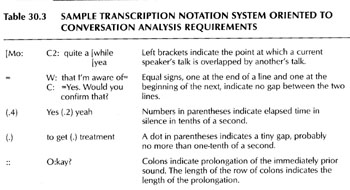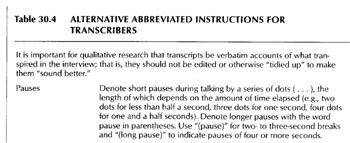

Patton, Michael Quinn. Qualitative Research and Evaluation Methods (3rd ed.). Thousand Oaks: Sage Publications, 2002. (amazon.com page)
Gubrium, Jaber F. and James A. Holstein, eds. Handbook of Interview Research: Context and Method. Thousand Oaks: Sage Publications, 2002. (amazon.com page)
by Jeremy Garsha, April 2003
Those interested in conducting, transcribing, and analyzing interviews should definitely pick up Michael Quinn Patton’s Qualitative Research and Evaluation Methods. This book provides an excellent jumping off point for both novice student interviewers as well as seasoned teachers. Patton, himself an experienced interviewer, and also an award-winning teacher and storyteller, outlines all the necessary steps involved in the interview process in a very entertaining way. The book reads much like a textbook, complete with original cartoons, historical examples, and vast personal experience. Moreover, inspirational and often amusing quotes kickoff each section. Appearing throughout the book is the fictional sage-like character Halcolm, a philosophical alter ego of Patton, who, "like his name (pronounced slowly)," forces the reader to ask "how come?" (p. A2).
Patton has divided Qualitative Research and Evaluation into three main parts: Conceptual Issues in Qualitative Inquiry, Qualitative Designs and Data Collection, and finally Analysis, Interpretation, and Reporting. Under each section are many subsections, all clearly laid out in a very detailed table of contents. For example, Conceptual Issues is divided into four subcategories: The Nature of Qualitative Inquiry, Strategic Themes in Qualitative Inquiry, Variety in Qualitative Inquiry: Theoretical Orientations, and finally Particularly Appropriate Qualitative Applications. Furthermore, these four subcategories are then broken down in additional detail in the table of contents. The titles of these sections (and chapters) are somewhat typical for the text as a whole in that they rely on sociological terminology that may be unfamiliar to beginners. At first glance, the table of contents appears to be little more than a patchwork of intellectual vocabulary, but the book reads in much simpler terms.
The index to the book is also very useful for finding numerous narrowed down focuses. I found this the most helpful. For example, when I wanted to find out about transcribing interviews, I was able to find all of the relevant chapters and information at once.
Unfortunately, however, Patton’s broad scope is also his main weakness. It is very easy to become bogged down by the mass amount of details and by his many examples. Also, for scholars primarily interested in the interview process, only the final section is useful, especially in the field of analysis.
Patton attempts to cover all of the basics of interviewing, and provides an excellent outline, but nothing can compare to actual experience. Nevertheless, it is highly recommended that first-time interviewers consult Patton’s book for an introductory guide, and even veteran interviewers can learn something from Patton’s vast experience.
Researchers will also find Patton’s 36 pages of single-spaced references very helpful, and graduate students will find it invaluable for dissertations.
UCSB faculty and students will find Michael Quinn Patton’s Qualitative Research and Evaluation Methods in the Davidson Library for a regular loan, under the call number H62.P3218 (2002). It is available for purchase at $68.
 |
 |
A highly recommended supplement to Patton’s Qualitative Research and Evaluation Methods is the Handbook of Interview Research edited by Jaber F. Gubrium and James A. Holstein. The editors, both Sociology professors, have amassed a 981-page handbook that can answer almost any question pertaining to interviewing, and is especially useful because it expands in greater detail on the broad themes covered by Patton. The manual has articles on interviews for Medical Studies, Therapy, Education, Employment, and even Forensic Investigation. I found the section on Distinctive Respondents the most helpful. Here Gubrium and Holstein have gathered essays which act as a guide for interviewing Children and Adolescents, Men, Women, Older People, Social Elites, and the Ill. For my own research, the article on adolescent interviewing was extremely helpful. Unfortunately, the article’s primary focus was on younger children. However, the adolescent section still provided me with enough information to better my studies. The book also contains an up-to-date section on Technical Issues, which among other things tells readers how to conduct interviews via the Internet, over the phone, and naturally in-person. Under this section there is an article titled Transcription Quality, where the author includes an invaluable chart for transcription abbreviation (p. 639 print version, 641 print version) that I have been unable to locate anywhere else.
The Handbook of Interview Research also devotes an entire section to Analytic Strategies, with significant pages on analyzing Oral History Interviews.
When used in conjunction with Patton’s Qualitative Research and Evaluation Methods, Gubrium and Holstein’s Handbook of Interview Research will easily provide an interviewer with all the necessary background knowledge.
UCSB faculty and students will also find the Handbook of Interview Research available on a regular loan at the Davidson Library, call number H61.28.H36 2002. (cost: $130)
back to top, Oral History page, UCSB
oral history project
prepared for web on April 30, 2003, chart images added 6/11/03